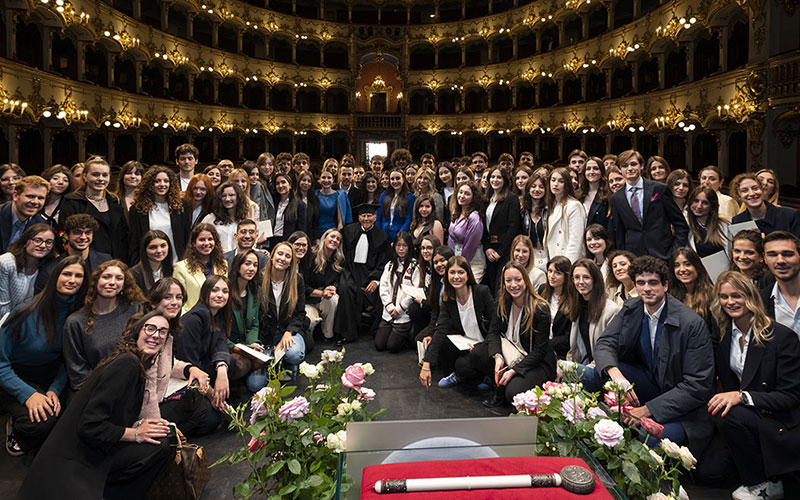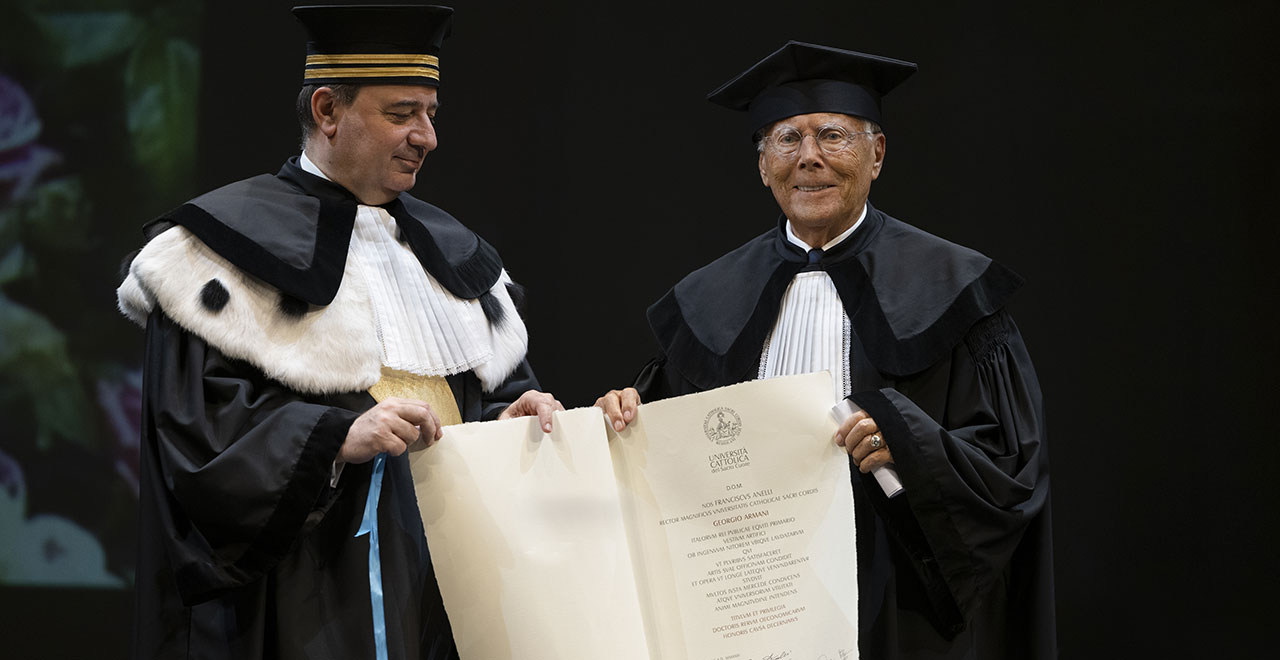
News | Piacenza
Giorgio Armani receives honorary degree in Global Business Management
| Francesco Berlucchi
12 maggio 2023
Condividi su:

Most Reverend Excellencies,
Distinguished Madam Mayor,
Distinguished Headmasters and Professors,
Distinguished Knight Giorgio Armani,
Dear Students,
Ladies and Gentlemen
The Faculty of Economics and Law has decided to confer the honorary degree in Global Business Management on one of the most illustrious sons of the city of Piacenza, who has honoured its image throughout the world.
It will be the Headmistress, Prof. Anna Maria Fellegara, who will expound the specific motivations for this solemn act, which, moreover, is immediately justified by the evidence of the entrepreneurial reality that Giorgio Armani has been able to create through decades of passionate work.
An important enterprise, enormously successful, but an undoubtedly special enterprise, because it thrives on a synthesis of aesthetic finesse, originality, vision and craftsmanship. In this way, what Pope Francis defined, in a speech addressed precisely to universities, as the harmony of the three intelligences: of mind, heart and hands, is realised.
Style is not just elegance of design, balance of form, but tells the story of how each person stands in front of others, decorates the environments in which they live, chooses to represent themselves; and is, undeniably, an expression of a culture, individual and collective. And besides, said the arbiter Petronius, a mind cannot be creative if it is not imbued with culture (“flumine litterarum inundata”).
But let us listen to the clear words of today's graduate:
“Fashion for me is a craft, made up of imagination and concreteness, intuition and rigour, momentum and control. [...] It does not spring from the song of the muses, from a poetic daze, from a creative rapture. Making fashion is about developing a coherent idea of beauty and sharing it with your audience, taking into account the different realities of contemporary life”. This definition that Giorgio Armani gives of himself in his recent autobiographical book Per amore[1] is, at once, a declaration of intent and the balance of an extraordinary career in which “pragmatic invention”, the synthesis of design and product, has been at the heart. There are countless testimonies to the persistence and consistency of inspiration and method: in an interview dating back to 1980, five years after the founding of the company that bears his name, Armani describes himself as a “worker, foreman, surveyor, fashion architect”, adding: “the stylist today cannot but be a manager”[2].
More than forty years elapse between the two statements, but the principles remain consistent, and even the tone of voice with which they are expressed, at once polite and self-possessed, remains unchanged: a sign of the organic nature of the choices that have characterised Armani's presence in the world of fashion from the very beginning.
We seem to rediscover, with him, the figure that had presided over the birth and development of the artistic workshops in the Italian Renaissance, organisations “marked by a strong artisan accent”, in which production processes were structured to correspond to very varied commissions and all aspects of artistic activity – from the creative idea, to accounting, to publicity – were linked together in a system of references and relationships capable of giving a particular physiognomy to the finished product. It was precisely the indistinguishable interweaving of invention and manufacture that had designed the fabric of that fervid creative period, transforming the peninsula into a “great workshop” (to use the definition of the great Renaissance art historian André Chastel)[3].
In many respects, that admirable experience was transferred by osmosis into the most sensitive and refined part of contemporary Italian design, which expressed its specific version in the era of industrial capitalism geared towards mass production, when creative design began to concern “categories of objects” rather than a single, unrepeatable specimen.
It is a central passage, which anthropologist Arjun Appadurai summarises as follows: “It is not that there is no connection between art and design; it is that design rather mediates the relationship between art, engineering and the market. And while the latter two emphasise repetition and commodification, the former emphasises singularity”[4].
It is precisely here, with its own touch, that Armani's “craft” is located, inextricably linking creativity and enterprise through a variable that remains independent and distinctive with respect to the different declinations, applications, experiences crossed along the way. “Art, the real kind, with a capital A”, writes the designer, “is made to last. Fashion, on the other hand, runs out quickly, renewing itself ceaselessly, and is linked to everyday life. It also has to do with customs and consumption, with roles, with the representation of the individual and society. It is a very important expression of the culture of every people, but at most it is applied art. I have always seen my role as closer to that of a sociologist than that of an artist. I have always offered my audience new tools of emancipation and self-representation, capable of giving new meanings to everyday gestures”.
In fact, as Walter Benjamin said as early as 1936, in the age of technical reproducibility we have lost “the hic et nunc of the work of art – its unique and unrepeatable existence in the place where it is located”.
But industrial production offers new and multiple opportunities to artistic creation, including making products accessible to the masses. And yet, that creativity must confront the inevitable transience of what mass production is.
And here is the crux, the junction, the great obsession: time. If the reasons for the existence of fashion, a social product in itself ephemeral and obsolescent, exclude staying, any reflection on style can only be oriented towards lasting. This gives rise to a contradiction whose meaning is relevant to read; as Roland Barthes wittily does in an article, which appeared in 1967 in a fashion periodical [5], about what he calls the match between Coco Chanel and André Courrèges that then divided French haute couture: “Chanel, it is said, prevents fashion from trespassing into barbarism, it fills it with all the values of the classical order: reason, naturalness, permanence, the taste to please and not to amaze. [...] Courrèges, it is said, dresses the women of the year 2000, who are the young girls of today [...] and is rewarded with fabulous qualities of an absolute innovator: young, tempestuous, galvanic, virulent, crazy for sport, a lover of rhythm, reckless to the point of contradiction [...]. All this gives the impression that something important separates, on all levels, Chanel and Courrèges – something deeper than fashion, or at least of which fashion is only the circumstance of appearance. What is it?”[6]
Classicism versus modernism, tradition versus innovation; the sublimated and therefore timeless time of chic in relation to a fashion that is young because it is understood as always new: in this “duel” Barthes sees, more than a choice of field, a necessary social phenomenology, and in the “names of Chanel and Courrèges [...] the two necessary rhymes of the same couplet or the opposite feats of a pair of heroes without which there would be no good story”.
Here, an overall assessment of Giorgio Armani's work could be drawn up from this starting point: that is, from the assumption, in all its implications, of the problematic dimension of time. Durability, for Armani, is a choice of form and content: classic lines and quality of material speak of a product designed to withstand the wear and tear of a collection with ease. But the novelty of his proposal has to do with his sensitivity and timeliness in interpreting the attitudes, roles and functions of contemporary men and women, without forcing them: “be yourself, but at your best”.
In this sense one can speak of Armani's classicism, not as a petitio principii, but as the product of an aesthetic innervated with dynamic tensions in the manner of great classical sculpture; the fruit, born almost instinctively and then pursued consistently, of a mobile and open dialogue with man.
“The essence of classicism”, wrote Georg Simmel, one of the fathers of sociology, in his famous essay “Fashion” (1910), “is a concentration of the phenomenon around a central fixed point; classicism has a collected character, which does not offer, so to speak, footholds on which to graft changes that might upset or destroy the balance. Classical sculpture is characterised by the convergence of the parts, by the absolute dominance that the interior exerts over the whole, by the fact that each individual part is pervaded by the spirit and sense of life of the totality of the phenomenon through its compact visible connection”[7].
Armani's classic is not afraid of modernity, on the contrary, he welcomes it, interprets it and often anticipates it: in him, the designer and the sociologist move in synchrony like Dioscuri, protagonists of the “beautiful story” prefigured by Barthes.
Man invents clothing to protect himself from the elements, to conceal his nakedness, to make himself conspicuous through adornment. “This is valid”. Barthes goes on to write. “But another function must be added, which I feel is more important. Wearing a dress is fundamentally an act of signification, thus a profoundly social act, installed at the very heart of the dialectic of society”[8].
The idea is taken up by Malcom Barnard in “Fashion as communication” (1986), in which fashion becomes one of the sites of the tension between conformism and individualism, between the tendency towards social equality and that towards individual differentiation.
In the past, clothing was rigidly codified in terms of what was permissible (socially, but sometimes also legally), appropriate, and distinctive with respect to class organisation. Today, the grammar of dress has gained in freedom and polysemy what it has lost in schematism and conventionality: fashion is all the more promiscuous, plural and ambiguous the more subjective it is, but it remains equally active in expressing social value, objectifying identity messages and pointing out belonging, distances, recognition. What produces definition is not so much the individual object, but rather the context, i.e. the relationship between objects at the centre of which is the individual-consumer with his or her choice options.
The impulse to broaden the gaze from the object to the context has been the root and consequence of the global expansion of the Armani brand, which today defines a “style” not only in clothing, but in various sectors of what is in a word called lifestyle. The eclecticism of the entrepreneurial choices does not contradict, but rather enhances, the humanistic coherence of the inspiration: from the unstructured jacket, the most iconic of Armani's creations, a project for a house, a hotel, a place of entertainment was born out of contiguity, crossing the ancient passions for cinema and sport and extending to outline a personal interpretation of glamour: “behind is my eye and inside is my taste”, likes to say the author of this complex and multifaceted creature. On the horizon, there is the future.
The perspectives that have emerged in recent decades call for a re-evaluation of the very principles underlying the design and production processes. Their sustainability, social and environmental, begins when the reasons of what lasts win out over those of what passes, leaving all its scars: this – we hope – we understand better today than yesterday. An open, programmatic letter, published by Armani, at the height of the pandemic, in a trade periodical [9], reflects on these issues and addresses their critical aspects, with a keen sense of responsibility and an impetus barely tempered by the usual pragmatism. But he has not fallen on the road to Damascus: his figure, less but better [10], is already in line with the new time ahead.
Therefore, the degree being conferred today is not a retrospective celebration, but a stage in a creative journey from which much is still expected.
[1] Giorgio Armani, Per amore, Rizzoli, Milan 2022.
[2] Roberto Gervaso, “It is easier to dress women”, interview with Giorgio Armani, Corriere della Sera, 20 August 1980
[3] André Chastel, La grande officina. Arte italiana 1460-1500, Rizzoli, Milan 1965.
[4] Arjun Appadurai, La vita sociale del design, in Il futuro come fatto culturale, Cortina, Milan 2014.
[5] “Marie Claire”
[6] Roland Barthes, The Chanel Courrèges Match, in Il senso della moda, Einaudi, Turin 2006.
[7] Georg Simmel, Sulla moda, Mondadori, Milan 1996
[8] Roland Barthes, Tempo e ritmi dell'abbigliamento
[9] WWD.
[10] It was industrial designer Dieter Rams who coined it.
Speech
